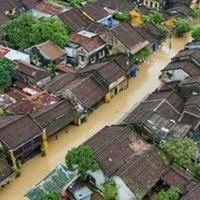Record-breaking rainfall swept across central Vietnam this past week, unleashing catastrophic floods that have left at least 35 people dead and five more missing, according to disaster management officials. The relentless deluge, which began over the weekend, has pummeled Vietnam’s coastal provinces with an intensity not seen in decades, submerging homes, crippling infrastructure, and upending daily life for hundreds of thousands.
Meteorological records indicate that up to 1.7 metres (approximately 5 feet 6 inches) of rain fell within a single 24-hour period between Sunday, October 26, and Monday, October 27, 2025. This staggering volume of rainfall marks the highest recorded in the region and has triggered a chain reaction of devastation across multiple provinces, including Hue, Da Nang, Lam Dong, and Quang Tri. The Vietnam Disaster and Dyke Management Authority (VDDMA) confirmed the death toll and the ongoing search for those still unaccounted for as of Sunday, November 2, 2025.
One of the most striking images of the disaster comes from Hoi An, the ancient town renowned as a UNESCO World Heritage site. The historic streets of Hoi An, typically bustling with tourists and locals alike, have been transformed into waterways. Waist-deep floodwaters have forced residents to abandon vehicles for wooden boats, navigating what used to be charming alleyways now submerged beneath the swollen Thu Bon River. The river’s water level has reached its highest point in 60 years, a stark reminder of nature’s unpredictability and power.
“Everyone is in shock after the flood,” said Chuong Nguyen, a 43-year-old resident of Hoi An, in an interview with AFP as the rain continued to pour down. “People were preparing for the flood, but they didn’t expect the water to rise so high.” Nguyen went on to describe the sense of helplessness gripping the community: “Many homes weren’t able to get ready in time, so a lot of belongings were damaged. Everyone feels helpless due to the severe damage.”
The scale of destruction is sobering. The VDDMA has reported that more than 16,500 houses are currently submerged, with tens of thousands more affected by rising waters. The agricultural sector has been especially hard-hit: over 40,000 poultry and livestock have been swept away, and more than 5,300 hectares (13,000 acres) of cropland have been submerged, threatening food security and the livelihoods of countless farmers. Earlier in the week, Vietnam’s environment ministry estimated that over 100,000 homes had been flooded and documented more than 150 landslides across the affected regions, compounding the challenge for rescue and relief operations.
The situation in Hoi An has drawn particular attention from both local and international observers. The town’s status as a UNESCO World Heritage site underscores the cultural loss that comes with such natural disasters. Preservationists and residents alike fear that the floodwaters may have inflicted irreparable harm on centuries-old structures and artifacts. For now, the focus remains on immediate relief and safety, but the long-term impacts on Hoi An’s heritage are likely to be significant.
Vietnam’s central region is no stranger to severe weather, but the intensity and frequency of recent events have alarmed scientists and policymakers. According to climate experts cited by AFP and other outlets, the increasing severity of such extreme weather is closely linked to human-driven climate change. Rising global temperatures are making storms and floods more deadly and destructive, a pattern that has become all too familiar in Vietnam, which lies in one of the world’s most active tropical cyclone regions.
Typically, Vietnam experiences heavy rainfall between June and September, with an average of ten typhoons or tropical storms impacting the nation each year. However, 2025 has already brought twelve such weather systems, surpassing the usual annual tally. This uptick in storm activity, paired with the record rainfall seen this past week, raises urgent questions about the country’s preparedness for an era of more extreme and unpredictable weather.
The human toll of natural disasters in Vietnam has been mounting. Government figures show that storms, floods, and landslides have left 187 people dead or missing during just the first nine months of 2025. The economic costs are staggering as well, with estimated losses exceeding $610 million (about R10.5 billion) for the period. The current flooding is now being described by officials and residents alike as one of the most severe weather events in recent memory, underscoring the nation’s vulnerability to the growing threat of climate change.
Efforts to respond to the crisis have been hampered by the sheer scale of the disaster. Emergency teams have been working around the clock to rescue stranded residents, deliver food and medical supplies, and restore basic services. Yet, with roads washed out and landslides blocking access to many areas, the challenges are immense. Images circulating on social media and news outlets show communities cut off by floodwaters, families huddling on rooftops, and volunteers risking their lives to provide assistance.
For those who have lost homes, livelihoods, or loved ones, the road to recovery will be long and uncertain. The destruction of crops and livestock not only threatens immediate food supplies but also imperils the economic stability of entire communities. In rural areas, where agriculture is often the backbone of the local economy, the loss of a harvest or herd can spell disaster for families already living on the edge.
As the waters begin to recede in some places, attention is turning to the daunting task of rebuilding. Authorities are urging residents to remain vigilant, warning that further landslides and flash floods are possible in the days ahead. Meanwhile, calls for increased investment in flood defenses, early warning systems, and climate adaptation measures are growing louder. The events of this past week have made it clear that Vietnam, like many countries in Southeast Asia, faces a future where resilience and preparedness will be more critical than ever.
“People were preparing for the flood, but they didn’t expect the water to rise so high,” Chuong Nguyen’s words echo the sentiment felt across the region. The shock, the loss, and the resilience of Vietnam’s people stand as a testament to the challenges and uncertainties of a changing climate. As the cleanup begins, the nation is left to reckon with the aftermath—and to plan for a world where such disasters may become all too common.





